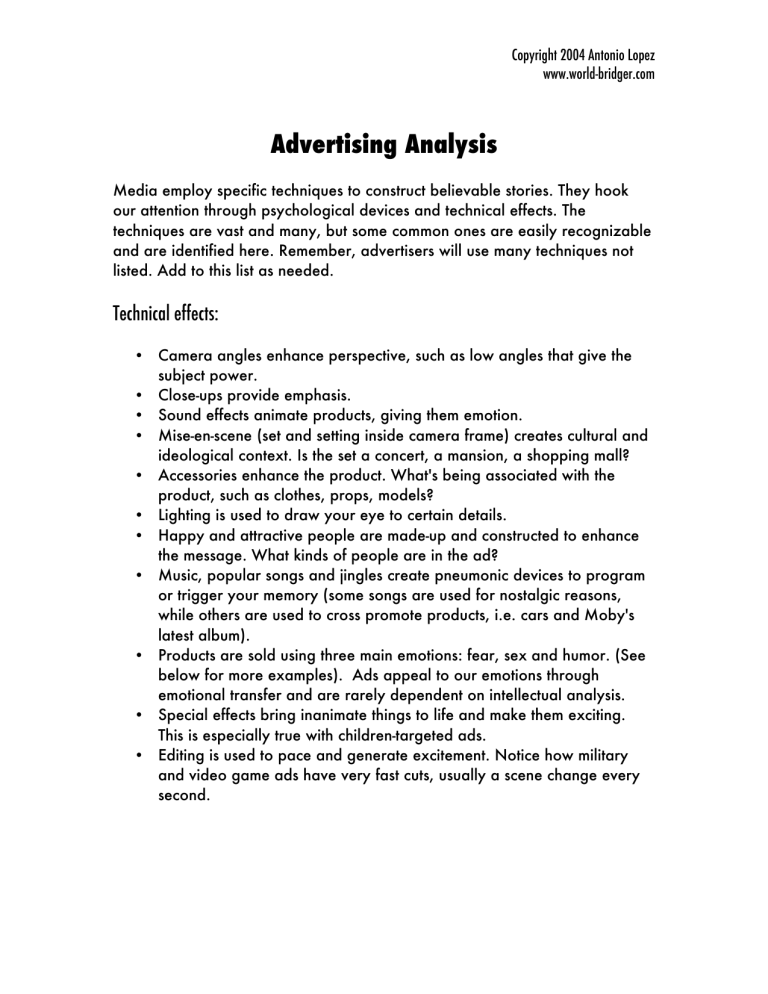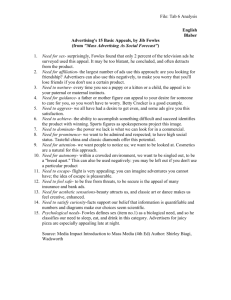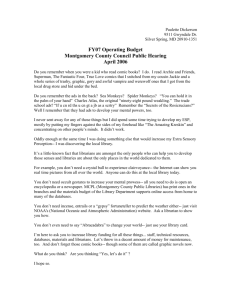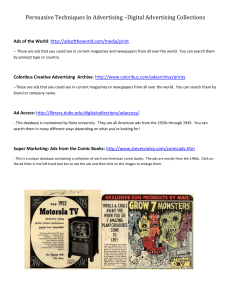Advertising Analysis

Copyright 2004 Antonio Lopez www.world-bridger.com
Advertising Analysis
Media employ specific techniques to construct believable stories. They hook our attention through psychological devices and technical effects. The techniques are vast and many, but some common ones are easily recognizable and are identified here. Remember, advertisers will use many techniques not listed. Add to this list as needed.
Technical effects:
•
Camera angles enhance perspective, such as low angles that give the subject power.
•
Close-ups provide emphasis.
•
Sound effects animate products, giving them emotion.
•
Mise-en-scene (set and setting inside camera frame) creates cultural and ideological context. Is the set a concert, a mansion, a shopping mall?
•
Accessories enhance the product. What's being associated with the product, such as clothes, props, models?
•
Lighting is used to draw your eye to certain details.
•
Happy and attractive people are made-up and constructed to enhance the message. What kinds of people are in the ad?
•
Music, popular songs and jingles create pneumonic devices to program or trigger your memory (some songs are used for nostalgic reasons, while others are used to cross promote products, i.e. cars and Moby's latest album).
•
Products are sold using three main emotions: fear, sex and humor. (See below for more examples). Ads appeal to our emotions through emotional transfer and are rarely dependent on intellectual analysis.
•
Special effects bring inanimate things to life and make them exciting.
This is especially true with children-targeted ads.
•
Editing is used to pace and generate excitement. Notice how military and video game ads have very fast cuts, usually a scene change every second.
Copyright 2004 Antonio Lopez www.world-bridger.com
Common Attention-Getting Hooks:
•
•
•
•
•
•
•
•
•
•
Emotional Transfer
is the process of generating emotions in order to transfer them to a product. For example, a Coke ad shows happy, beautiful people but tells us nothing about the product. The point is to make you feel good and to transfer that feeling to the brand or product.
This is the number one and most important process of media manipulation.
Sex
sells, without exception.
Fear
messages are directed at our insecurities, such as "no one will like you if you have dandruff," or "bald people are losers." This is a very common technique and extra attention is required to resist these messages.
Symbols
are easily recognized elements from our culture that generate powerful emotions, such as flags and crosses.
Humor
is often used because it makes us feel good and is more memorable. Notice how the majority of Super Bowl commercials are funny.
Hype
, don't believe it. Be skeptical of exaggerated claims, such as
"America's favorite burger." Statements like these are meaningless and vague, but sound good.
Fitting In
is a very common technique that tries to influence us by stating that if everyone else is buying the product, so should you. This is often seen in beer commercials, which promotes a "big lie" that everyone drinks (alcoholics are the main consumers of alcohol).
Cute
. Children and animals always steal the show. Family and “girl next door” also fit this category.
Vague Promises
like "might," "maybe," and "could" are red herrings that divert our attention. "Super Glue may heal cuts better than band-aids," sounds absurd, but you will often hear claims as preposterous as this and it would still be true (because it can't be disproved).
Testimonials
are statements by people explaining why certain products are great. Famous or plain folk, or actors can do them. This is more powerful when someone we really like or respect endorses a product
(such as Tiger Woods or Michael Jordan).
2
Copyright 2004 Antonio Lopez www.world-bridger.com
•
“
Beautiful”
people are usually used to glamorize merchandise, especially unhealthy products like alcohol, tobacco and junk food.
Models and actors generally have rare body types, and don't represent average people, but idealized notions of beauty that are constantly changing (compare, for example, Marilyn Monroe's body to a contemporary actress or model).
•
•
•
•
Famous People
such as Michael Jordan make products appealing and attractive through association.
Ordinary People
are people that might be like you or me. This is common in ads that stress community or family, like Wal-Mart.
It's Easy.
Simple solutions are often used to convince us that a product will solve our problems, such as "bald spot hair spray will get you a date," or "doorknob disinfectant wipes keep us healthy." Larger ideological messages are common as well, such as "cars enable us to conquer nature."
Macho
is generally used to appeal to males, but not exclusively. It demonstrates masculinity and male stereotypes; these are common in military and tobacco ads.
•
•
•
•
•
Femininity
is another gender stereotype used in a variety of ads, from teen make-up commercials to alcohol ads.
Repetition
is done to reiterate a sales pitch over and over again, like the phone ads that repeatedly display and annunciate the phone number to access their service (for example the Carrot Top ATT ads).
Big Lies
are exaggerated promises that are impossible to deliver, such as, "This is America's best all-whether vehicle" (also see hype). More subtle examples include "eating Sugar Corn Flakes will make you as strong as an Olympian."
Exotic.
This is the appeal of the “other"; it could be a beach location, tribal person, something strange or unknown. This is often meant to hook you through presenting something that is out of the ordinary or beyond our everyday experience.
Flattery
is used to make you feel good about you as a consumer and that you are making the right choice when you chose a product. "Smart people like you always buy premium aquariums when purchasing exotic fish…"
3
Copyright 2004 Antonio Lopez www.world-bridger.com
•
•
•
•
•
Social Outcasts
generally represents a put-down or demeaning comment about a competing product or cultural group. This is not limited to ads, but is common in propaganda as well ("they don't believe in God," etc.).
Free Lunch
offers you something in addition to the product such as "buy one, get one free" or tax cuts. Freebies constantly hook us, but there are always hidden costs. Rarely is a thing truly free.
Surrealism.
Commercial media employ some of the brightest minds of the media world and often require cutting edge artists to keep their material fresh (e.g. MTV). Often, as a reflection of how unreal the fantasy world of media is, you will see juxtapositions and dream-like imagery that make no sense because the advertiser is trying to get your attention by presenting something strange and different.
The Good Old Days
. Images, fashion, film effects and music depicting specific eras or subcultures are meant to appeal directly to the demographic represented in the ad (e.g. VW bus, classic rock music, sepia tone effects).
Culture.
Niche marketing is more common as advertisers hone their messages for specific cultural groups. Latino-targeted ads, for instance, might have family scenes or specific uses of language.
4






